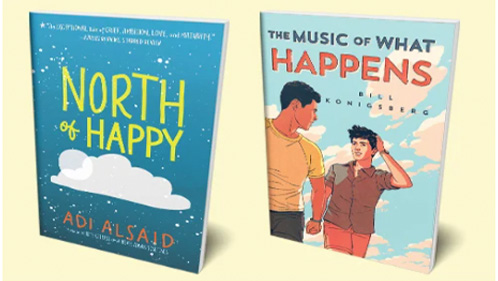The Gift of Reading: Romancing the Fruitcake—A Tale of Two Genres
For the past two weeks on my morning runs, I’ve been listening to the podcast Christmas Wars: A Very Merry Rivalry on the battle for Christmas movie...
AP & Honors Mathematics
Explore Wiley titles to support both AP and Honors mathematics instruction.
Literacy Skills & Intensive Reading
Connections: Reading – Grades 6–12
Empower student success with a proven intensive reading program that develops strong reading skills in striving readers.
Drama, Speech & Debate
Basic Drama Projects 10th Edition
Build students’ confidence and competence with comprehensive, project-based theatre instruction.
Literature
Connections: Literature
Support learners as they study dynamic, relevant texts and bring the richness of diverse voices to students through literature.
Literature & Thought
Develop critical thinking, reading, and writing across literacy themes, genres, historical eras, and current events.
Language Arts
Vocabu-Lit® – Grades 6–12
Help students build word power using high-quality contemporary and classic literature, nonfiction, essays, and more.
Connections: Writing & Language
Help students develop grammar, usage, mechanics, vocabulary, spelling, and writing and editing skills.
Reading/English Language Arts
Measuring Up to the English Language Arts Standards
Incorporate standards-driven teaching strategies to complement your ELA curriculum.
English Language Learners
Measuring Up for English Language Learners
Incorporate research-based best practices for ELLs with an approach that includes a focus on language acquisition strategies.
Mathematics
Measuring Up to the Mathematics Standards
Incorporate standards-driven teaching strategies to complement your mathematics curriculum.
Foundations
Measuring Up Foundations
Help students master foundational math skills that are critical for students to find academic success.
Science
Measuring Up to the Next Generation Science Standards
Give students comprehensive NGSS coverage while targeting instruction and providing rigorous standards practice.
Assessment
Measuring Up Live
Deliver innovative assessment and practice technology designed to offer data-driven instructional support.
For a better website experience, please confirm you are in:
2 min read
Perfection Learning Jun 2, 2023 4:18:47 PM

The goals of ELA instruction in middle and high school range from developing basic reading comprehension and writing skills to reading and writing critically and analytically. National standards for middle and high school ELA include objectives targeting lower-level skills like explicit text comprehension (e.g., “Cite textual evidence to support analysis of what the text says explicitly as well as inferences drawn from the text”) as well as higher-order skills, such as evaluation of the structure, quality, and veracity of information in a text (e.g., “Delineate and evaluate the argument and specific claims in a text, assessing whether the reasoning is valid and the evidence is relevant and sufficient; identify false statements and fallacious reasoning”) (National Governors Association Center for Best Practices & Council of Chief State School Officers, 2010).
To help educators classify wide-ranging educational objectives for instruction and assessment of learning, educational psychologist Benjamin Bloom developed a hierarchical taxonomy of cognitive processes that range from simple to complex (Bloom, 1956). While the original taxonomy contained categories like “knowledge” and “comprehension,” the taxonomy was updated in 2001 with categories like “remember” and “understand” that better capture the dynamic nature of these cognitive processes (Anderson & Krathwohl, 2001). The revised taxonomy is shown in Figure 3.

The lower levels of Bloom’s taxonomy focus on the simpler processes of remembering and understanding; the middle levels build on these basics with application of knowledge and skills to new contexts and analysis of structures and connections between concepts; and the higher levels include metacognitive skills like evaluating and critiquing information and its presentation as well the creation of one’s own works. Literacy instruction is most effective when skills are developed explicitly, systematically, and cumulatively, from simple to complex, connecting new skills to what was previously learned (Cowen, 2022). Building curriculum around these hierarchical levels clarifies the goals of learning for teachers and students and provides a developmentally appropriate pathway to acquiring increasingly higher levels of skills and knowledge.
Close reading is an instructional approach that scaffolds students’ ability to engage with text in increasingly complex ways, supporting systematic development of cognitive skills. According to Brown and Kappes (2012), close reading “involves an investigation of a short piece of text, with multiple readings done over multiple instructional lessons. Through text-based questions and discussion, students are guided to deeply analyze and appreciate various aspects of the text, such as key vocabulary and how its meaning is shaped by context; attention to form, tone, imagery and/or rhetorical devices; the significance of word choice and syntax; and the discovery of different levels of meaning as passages are read multiple times” (p. 2). Studies of close reading in middle and high school have found that repeated reading of complex, grade-level texts; use of a gradual release of responsibility instructional framework; annotating text while reading; responding to text-dependent questions; and discussion of the text have positive impacts on reading comprehension (Fisher, 2014; Fisher, Frey, & Hattie, 2016; Paddle & Woolett, 2020; Janus, 2017).


For the past two weeks on my morning runs, I’ve been listening to the podcast Christmas Wars: A Very Merry Rivalry on the battle for Christmas movie...

How do I get my kids in reading and writing shape, so they can move forward? Here are 6 questions I am asking myself as I attempt to help students...

In Texas, we love our air conditioning. We are a little spoiled with it and have been known to crank it up starting in early March.

With an emphasis on close reading, analysis, and full-length essays, losing track of sentences is easy. Join Dr. Brandon Abdon, author of our AP®...

Join Laura Kebart (LanguageArtsTeachers.com) for a fun walkthrough of four strategies to keep your middle school ELA students engaged all year long!

For many years, LOR—for most English teachers—stood for The Lord of the Rings. But now, LOR has come to stand for something seemingly even more...

In a season of mistletoe and merriment, the only thing missing from the holiday is mutant bugs.

With schools thrust into online education models, it is more important than ever to ensure the proper support is in place for all students. How can...

Most AP English teachers now find themselves well into this critical second half of the school year. With the AP exam quickly approaching in May (I...

The Free-Response Question (FRQ) portion of the Advanced Placement® exam provides test takers with the opportunity to demonstrate their knowledge on...

Scads of English teachers have shown the movie Dead Poets Society in class to either begin their poetry unit or to try and inspire an appreciation...

There are so many more interesting methods to writing a character analysis than writing an analysis paragraph. Oftentimes, English or language arts...
